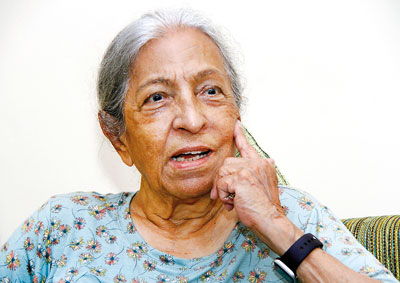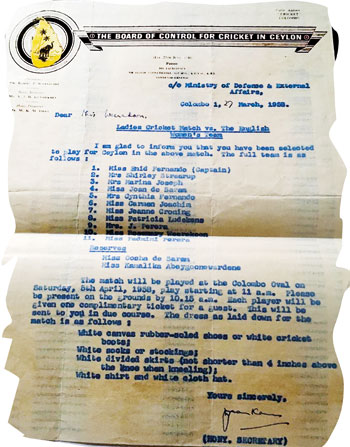Teenager Rosemarie Weerakoon’s one-off cricketing adventure in 1958

Rosemarie Weerakoon, now in her 80s - Pix by Indika Handuwala
Long before women’s cricket in Sri Lanka found its place in the spotlight, before national contracts, televised matches, or the roar of packed stadiums, young Rosemarie Weerakoon stepped onto the Colombo Oval on April 5, 1958, for what would be her first and last official game of cricket.
A teenager at the time, Rosemarie took to the field with courage, backed by the unwavering support of her brothers — Ronnie and Bradman. It was an era when cricket remained firmly within the domain of men, a gentleman’s game that few imagined women would ever play.
Growing up in a cricket-obsessed family who ‘lived and breathed cricket’, Rosemarie was no stranger to the sport. In 1958, it was a newspaper notice that caught her eye.
“I saw in the newspapers one day that they were selecting people to play cricket, a women’s team. I thought, well, that’s something I can try.”
To this day, she still has the letter she received confirming her selection to the team. The letter outlined the dress requirements in detail: players were to wear white canvas rubber-soled shoes or white cricket boots, white socks or stockings, white divided skirts not longer than four inches above the knee when kneeling, a white shirt, and a white cloth hat.
“When I told my brothers I wanted to play cricket, and they were fully supportive,” she recounts.
“The next thing I knew, they hung a sock with a leather ball in the back of the house. And I would hit this ball off the table and train myself.”
It was that backyard training that led her to represent Sri Lanka in the one-off match against a visiting women’s team from England, stopping over en-route to Australia.
“We were badly beaten, but it didn’t matter,” she says with a smile.
For her, the game holds a personal memory: “What was memorable was that I had my brothers sitting in the pavilion watching me for a change. Usually, it was the other way around, as I would be running around the field watching them.”
 “They played a lot of sports themselves,” she recalls of her older brothers.
“They played a lot of sports themselves,” she recalls of her older brothers.
“I was much younger, but as I grew up, they became my heroes.”
As she recalls, she was the youngest player on the team. The challenge, she says, was balancing school and cricket.
“It was mainly trying to combine school and going for practises. We had about three months of practising.”
Rosemarie’s cricket career ended as abruptly as it began.
“I finished school, and I went off to England. So that was the last I ever played cricket.”
Although her time with cricket was short-lived, her passion for the game never faded.
“I love the game. I still watch it.”For Rosemarie, cricket was more than just a sport. “The team spirit of the game makes you accept that you’re not the star of the game. Sometimes you’re lucky. Sometimes you’re not.”
She encourages today’s young players, especially girls, to stay the course.
“Just keep at it. And you’ll get there. And don’t give up because you’ll get pulled out or because you missed a catch. You just have to keep trying and train for it.”


